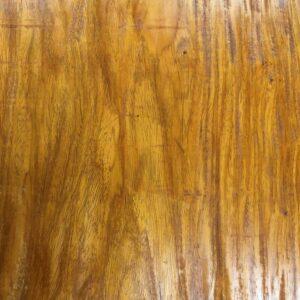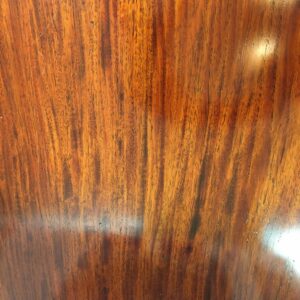A good friend gifted me a table. It is solid wood and was made when my friend was in the Philippines in the military 35+ years ago. He said the wood is Jarrah, but when I look this up I find Jarrah comes from Australia. The craftsman would only have used local wood so I’m stumped as to what this might be. And maybe there is a Philippine wood known locally as Jarrah. There are two wide slabs glued together, both just under 20″ wide. Length is 88″.
The pictures below show what I have. One unfinished (still showing bandsaw marks), one finished. I sprayed some water on the unfinished side and tried to avoid the glare when I took the pics.
I want to make something out of the top but need help with finishing it. Can anyone give me an idea of what finish this is? Did they dye or stain the wood? Use pore filler? I’m guessing the final finish is lacquer.
I’m OK at making and assembling things but finishing is my weak point. Any ideas and suggestions would be much appreciated.

















Replies
Yellow/ green --petrocarpus something ,don't fault me for my spelling... Narra, native to Philippines and SE Asia , rhymes with jarra. I'd think maybe BLO or tung oil or varnish.
I don't think they used stain. Probably some yellowing from the original finish.
I take it you are using the wood to make something new? Don't worry about what they used.
When you finish, fill the grain or not. It's yours! I don't personally like the look of filled grain, but that's me.
For a tropical wood of unknown qualities, I'd seal it with dewaxed shellac first, then use a different topcoat. If it is an oily wood, many finishes won't adhere well, and the seal coat of shellac should fix it.
The yellowing is the natural color of Narra (often) though it can tend towards red. It's a pretty dense hardwood almost like a rosewood or padauk, which it is related to. They use it alot for carving and really clunky Spanish colonial influenced carved Phillapino furniture. It was an available wood for a project I did over that way but the coloring was unsuitable for what I was doing. I saw a couple of burley slabs though that were pretty amazing. I think it could finish with almost anything. I would think an oil based finish would make it really pop.. like a lot of tropical hardwoods you would probably need to use lacquer thinner on joined surfaces before gluing.
I’m trying to learn; why do you need the lacquer thinner for tropical wood before glueing?
Any woods that have a lot of natural oils tend to not take glue or finish well. Wiping with something like alcohol removes some of the surface oil and let's the glue stick.
Jarrah is an oily wood. It looks a little too open-grained to me but it's a good chance I'm wrong. Sanding it smooth then coating with shellac will seal the oil in, allowing the glue to hold effectively.
I like the idea of filling pores. The process will give a smoother, more even finish.
Are you suggesting he seals his wood with shellac before gluing? Wood glue will not hold on sealed / finished / stained surfaces. If you get it to stick together in the short term it will have a weak bond at the joint line and fail in the long term.
Except it's not jarrah. I don't think I'm wrong that it's narra but it's possible. As to jarra -- that clearly is not jarra.
Sealing with shellac will seal oils in but also seal oils out. A top coated finish will eventually need redone or repaired. A hand rubbed oil finish is forever,totally forgiving, and really easy. Dulls down, just give it another feeding. One needs to experiment but if I was working with Narra I'd be thinking pure tung oil and pass on the polymers. What I've seen of narra, it finishes well and doesn't appear to be open grained. It's used alot for carving and my take on carving is that the closer a type of wood gets to the consistency of a bar of soap the more popular it is with carvers.
This forum post is now archived. Commenting has been disabled